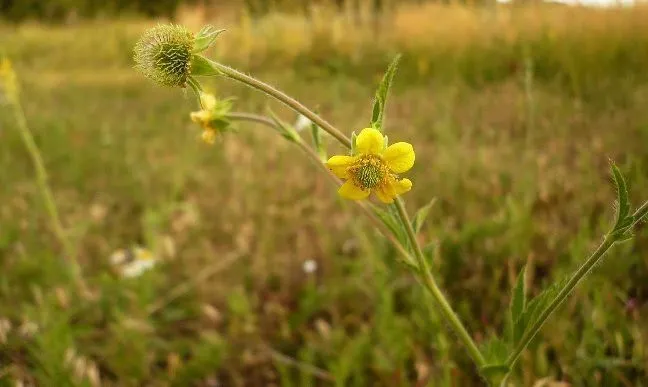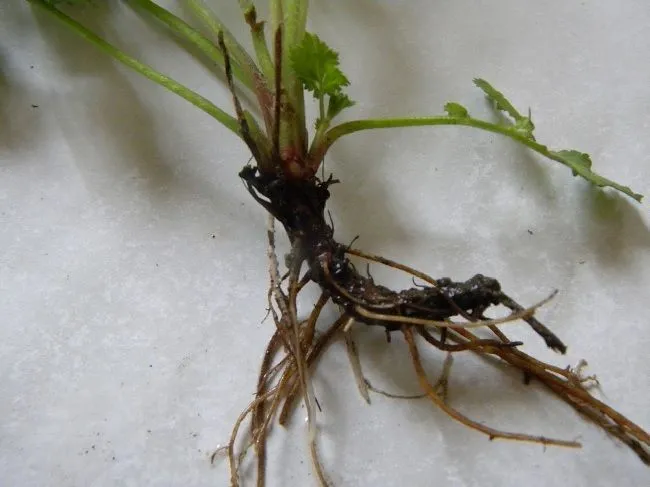We find a plant, Geum urbanum, which stands out for its medicinal properties against stomach pains. Although other benefits are also attributed to it, the composition of its extracts and principles are intended for this type of problem.
Its common name is St. Benedict’s wort, known more than by its scientific name in many parts of Spain.
If we see it with the naked eye, as we will see in some of the images, it is not a very attractive type of plant nor does it help us to find out the potential as a medicinal plant.
A low-sized herb, with a yellow flowering formed by 4 petals, with a diameter not exceeding 2 cm.
The medieval history tells us that Geum urbanum it was also known as blessed grass, as he was given powers to ward off demons and evil spirits.
Therefore, it was common to see how the people of the Middle Ages carried parts of the plant, especially parts of the root, used as an amulet.
Therefore, it has religious attributions, very common at that time, and that is why this medicinal plant is related to the Church, both by the name of St. Benedict’s herb and blessed herb.
In the book of Hortus Sanitatis the following sentence is mentioned, speaking of Geum urbanum.
“Where the root is the house, Satan can do nothing and if a man carries the root on him, no poisonous beast can do nothing to him.”

Table of Contents
Habitat and agronomic characteristics
St. Benedict’s wort is a rather rustic plant, spontaneously growing in all kinds of places.
Its presence has been detected in forests, boundaries, paths, thickets, stony roads and walls.
It has a presence both in Europe (distributed by all countries practically) as in Middle East. That is why it has had such a presence in medieval times.
Flowering season: from late spring to mid-autumn.
Medicinal properties of Geum urbanum
The power of a plant as medicinal is attributed to the content and composition of its extracts or active ingredients.
The first thing to do when studying a plant is to evaluate the presence of these compounds. Let’s get to it.
Composition and active ingredients
- Tannins (20%), gallic type.
- Gallic acids (caffeic, chlorogenic and protocatechic).
- Essential oil (0.2-0.5%), mainly eugenol.
- Sesquiterpene lactones (germacranolide).
The high presence of tannins makes it have a great behavior as an antidiarrheal and astringent, broad-spectrum.
It can also help slow down and reduce inflammation of the mucous membranes (hemorrhoids, varicose ulcers, chilblains, etc.).
In fact, these properties can also be used topically to treat problems such as dermatitis, pruritus, conjunctivitis, erythemas, etc.
Collection of its components

The most important parts of Geum urbanum, due to the presence of its active ingredients are the root and rhizome, although in many cases the flowers have also been used.
The optimal time of harvest is when the plant begins its final stage, drying the leaves and stem, or near it.
In the event that you only want to collect the aerial part, especially the flowers, the exact moment will be in full flowering, discarding in this case the roots for low content of active ingredients.
Medicinal properties for internal use
- Gastroenteritis
- Asthenia
- Anorexia
Medicinal properties for external use
- Dermal, buccal or corneal wounds and ulcerations
- Blepharitis (inflammation of the eyelid)
- Conjunctivitis
- Parodontopathies (inflammation of the tissue surrounding the teeth)
- Pharyngitis
- Dermatitis
- Erythemas (superficial inflammation of the skin, characterized by red spots)
- Pruritus (itching, localized or generalized)
- Vulvovaginitis
Preparation mode
Internal use:
- Infusion: 50 g/l, infuse for ten minutes. Take four or five cups a day, after meals.
- Fluid extract (1:1): 20-40 drops, one to three times a day.
- Tincture (1:10): 50-100 drops, one to three times a day, before meals.
- Powder: 1 to 4 g per day, in three doses.
External use:
- Fresh plant, crushed, applied in the form of poultices.
- Decoction: 30 g/l, boil 10 minutes. Apply in the form of compresses, eye drops or eye baths (isotonize).
Contraindications
Precautions to take into account.
- Contraindicated in case of gastritis and gastroduodenal ulcers since tannins can irritate the gastric mucosa.
- Do not prescribe dosage forms with alcoholic content to children under two years of age or to people in the process of alcohol cessation.
- Take into account the alcohol content of the fluid extract and the tincture.
Bibliography consulted.
- Official College of Pharmacists of Bizkaia, “Vademecum de Prescripción de Plantas Medicinales. Phytotherapy» Editorial Masson CD version 1998.Bézanger-Beauquesne, L; Pinkas, M; Torck, M; Trotin, F. Plantes Médicinales des Regions Tempérées. Paris: Maloine, 1980, pp. 200-1.
- Bruneton, J. Elements of Phytochemistry and Pharmacognosy. Zaragoza: Acribia, 1991, p. 184.
- Fernandez, M; Nieto, A. Medicinal Plants. Pamplona: Ediciones Universidad de Navarra, 1982, p. 89.
- Paris, RR; Moyse, M. Précis de Matière Médicale. Take II. Paris: Masson, 1967, p. 422.
- Van Hellemont, J. Compendium of Phytotherapie. Brussels: Association Pharmaceutique Belge, 1986, pp. 178-9.
- Villar, L; Palacín, JM; Calvo, C; Gomez, D; Montserrat, G. Medicinal Plants of the Aragonese Pyrenees and other Huesca lands. 2nd. Huesca: Diputación Provincial, 1992, p. 261.
- Wichtl, M. Herbal Drugs and Phytopharmaceutical. A Handbook for Practice on a Scientific basis. Stuttgart: Medpharm Scientific Publishers, 1994, pp. 228-9.
